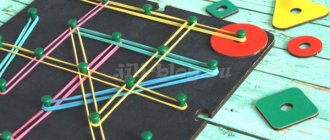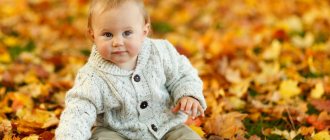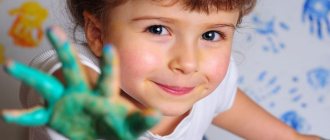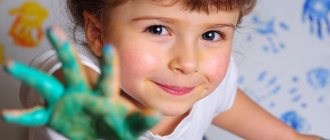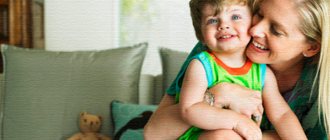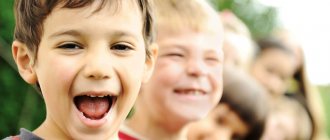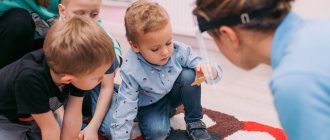The development of a child at this age directly depends on the efforts and attention that parents pay to this issue. Observations of many children show that children with intensive training (mom, dad, teachers in children's clubs) have more developed physical, cognitive and speech skills.
Also, children who have older brothers or sisters (they have someone to follow as an example) turn out to be more developed.
Let's take a closer look at all the skills that a baby should master at 2 years old.
What should a two-year-old child be able to do according to the Munich Diagnostic System?
For parents who want to know the norms of psychomotor development of children under 3 years of age, it is useful to get acquainted with the Munich functional development diagnostic system. It was developed in 1997 and includes practical indicators of child development. According to this diagnosis, by the age of two years the baby should be able to:
- Walk on tiptoes without adult assistance;
- Stand on one leg for a short time;
- Jump;
- Go up and down stairs while holding the railing;
- Open doors;
- Unscrew and tighten the caps;
- String large beads onto a cord;
- Build towers from cubes;
- Throw and roll the ball;
- Name animals;
- Name parts of the body;
- Sort by color, size and shape;
- Correlate the image in the picture with the real object;
- Sing songs;
- Speak in short phrases;
- Play with peers;
A two-year-old child is already quite independent. The baby already has quite well developed coordination, he is constantly in motion. With the help of adults, a two-year-old can easily take care of himself: go to the potty, drink from a cup, eat with a spoon, wash and dry his hands, undress. Support your child's initiative and give him freedom - this way he will quickly learn to be independent.
How a child’s speech is formed from birth to 3 years
The baby learns to communicate with the outside world from the very moment of birth. Let's take a look at how the speech development of young children proceeds during the first 3 years of a child's life. Norms of speech development in children from 0 to 3 years
- 0 – 2 months. Scream. The first form of communication for a child is crying. The baby cries when he is hungry, uncomfortable or tired.
- 2 – 3 months. Booming. Crying is replaced by cheering. The sounds “a”, “s”, “u” appear, sometimes in combination with “g”. The child learns to understand speech addressed to him and control his own sound intonations.
- 3 – 6 months. Babble. The baby begins to babble to himself and make sounds when addressed to him. Turns his head towards the sound. Freezes in response to a sudden loud sound. Cries differently depending on needs: “I’m hungry,” “I’m tired.” Recognizes his name and reacts to it.
- 6 months. First syllables. From the age of 6 months, you can notice that the child prefers strictly certain sounds to all others: “ba”, “ma” (they are the easiest to learn to pronounce). He can repeat them endlessly: he likes the way they sound.
- 7 – 9 months. Combinations of syllables. The babbling progresses to the utterance of identical syllables: “ma-ma-ma”, “dya-dya-dya”, “ba-ba-ba”.
- 9 – 11 months. Onomatopoeia. The baby imitates the sounds of adults' speech. Responds to name. Understands the meaning of the word “no.”
- 11 – 13 months. The first meaningful words from two identical syllables: “dad”, “mom”, “baba”, “uncle”. 12 months. The baby shows interest and attention to the speech of others, repeats and combines sounds in a new way, combines them into “words”, imitating the speech of an adult. Understands and follows simple one-word instructions (“sit down”). He waves his hand “bye-bye”, shakes his head “no”. Uses gestures and sounds to attract attention. Interested in books.
Rarely does a parent know what signs indicate deviations in the child’s development. Therefore, for prevention, be sure to visit a pediatric neurologist at 3, 6, 9 and 12 months.
- 18 months. The baby easily repeats frequently heard words. Knows different parts of the body and points to them. Masters simple words (by the age of 2 years, their vocabulary can range from 20 to 50). Answers in words or gestures the questions: “Where is the bear?”, “What is this?” He loves when people read to him. At the request of an adult, he points his finger at the pictures in the book. 2 years. First sentences (two words). A two-year-old child can easily combine simple words mastered by the age of 2 into combinations: “Mom, give me,” “I want this,” “Where is the kitty?” Understands simple instructions consisting of two sequential actions: “Find your teddy bear and show it to grandma.” The vocabulary can expand to 150 - 200 lexemes, and others can already understand half of the words the child pronounces. The baby begins to use pronouns, adjectives and prepositions. Holds a book correctly in his hands. “Reads” to his toys.
- 3 years. Multi-word sentences (three or more words). At 3 years old, the period of early childhood ends. By this turning point, the child is able to compose sentences of three or more words. Distinguishes between colors and size definitions. Remembers and repeats familiar rhythms, melodies, stories. Some difficulties in sound pronunciation may still persist (whistling, hissing, vowel sounds). The vocabulary is expanding so much that parents can no longer accurately count how many words it consists of. In general, the baby is already ready to speak out on any occasion.
Development of perception in two-year-old children
If in the process of movement the baby explores the capabilities of his body, then with the help of perception (vision, hearing, smell, touch, taste) the child learns about the world around him.
- Vision . It is through vision that children, like adults, receive most information about the world. Children at the age of 2 already have good visual coordination and are able to follow a moving object with their eyes and distinguish between horizontal and vertical lines. However, they cannot yet simultaneously perceive the whole and the parts, so if the baby is in a crowd, it will be difficult for him to quickly detect his adult.
- Rumor . It is worth paying attention to the child’s auditory perception, since if there are hearing problems, the baby will most likely experience difficulties in speech development. At 2 years old, a child should be able to distinguish intonation well and understand simple requests.
- Taste and smell . For some reason, in our culture, practically no attention is paid to the role of these analyzers in a child’s exploration of the world. At the same time, in France, the development of taste buds is considered an important stage in the psycho-emotional development of a child.
- Touch . Tactile contact with significant adults is very important for the mental and physical health of the baby. It is thanks to him that children develop trust in the world, a sense of security and love. In early childhood, tactile perception of objects is on a par with visual perception. Babies acquire ideas about such concepts as cold/hot, hard/soft, smooth/rough thanks to tactile sensitivity.
For the development of a 2-year-old child, it is very important that the baby receives as many impressions as possible. It is desirable that information be obtained from different sources. In the nursery, for the harmonious development of children, a Montessori environment is organized, from which every child can learn exactly what he needs at the moment.
A child is two years old: advice from a neuropsychologist
: Reading time:
An article by the neuropsychologist of our Center, Irina Anatolyevna Salnikova, in the magazine “Preschool Health Worker” (7, 2015) on the topic “A child is two years old: advice from a neuropsychologist.”
When a child turns two years old, an important period begins in the life of the family. Your baby has become an “adult”, he has his own opinion, he already knows a lot and is very inquisitive, i.e. actively strives to understand the world around him. And this requires a lot of patience and attention from parents.
As a rule, during this period, following the child’s activity, parents begin to intensively develop his cognitive skills (logical thinking, memory, speech), attending various developmental classes or conducting classes at home. However, we must remember: everything has its time and it is important not to overdo it, otherwise the proverb “If you hurry, you make people laugh” will be true. For example, the baby already knows many letters, but does not know how to eat on his own with a spoon or dress himself. A child develops in stages, and each period in development is very important and is associated with the knowledge, skills and abilities that he can acquire at a particular age. It should also be noted that developmental standards apply to most children, but not to all, because the development of each child is individual and depends on many factors. Therefore, dear parents, do not worry if at the moment your baby does not know how to do something, because only with the help of adults, i.e. you, he is studying.
Motor development involves assessing motor skills. At this age, the coordination and consistency of the child’s movements come to the fore, i.e. The better the baby can control and manage his body, the easier it is for him to explore the world around him and master new activities.
By the age of two, the child:
- knows how to walk, run (walks well in all directions, on uneven paths, steps over grooves, climbs hillocks);
- knows how to go up and down stairs, touching each step with one foot;
- knows how to jump (jumps up, jumps through a hoop or an obstacle lying on the ground);
- can kick the ball, throw it in a certain direction (for example, to another participant in the game or at the target), catch the ball with both hands;
- able to maintain balance on the crossbar;
- can ride a tricycle;
- can draw a vertical line;
- can build a tower or house from 4–6 cubes;
- knows how to cut paper while holding scissors with one hand;
- independently performs motor actions with objects on wheels (gurneys, cars, etc.).
The main goal at this stage is to continue to provide the child with freedom to practice coordination and develop dexterity. Closer attention should be paid to the development of fine motor skills. This is due to the fact that at this age there is a direct relationship between the development of small hand movements and the development of speech. In other words, by developing a child’s fine motor skills, you thereby contribute to the development of his speech.
At two years old, the following games and tasks can be offered.
- Learn to throw and catch a ball, throw it against a wall.
- Depict animal movements as shown by mother (jump like a bunny, wave your arms like a bird, stomp loudly like an elephant, crawl like a boa constrictor, etc.).
- Move around the room without touching objects scattered on the floor (for example, pillows), gradually increasing the pace and number of objects (like a labyrinth).
- Carry large but not heavy items (for example, a highchair, a light box of toys).
- Walking along a winding line drawn on the floor (or a strip of paper) develops coordination.
- Game "Catch the Sun Bunny". Play with the sunbeam that mom lets out.
- Collective outdoor games: dance in a round dance, run like a train after each other (children hold on to each other), games of “catch up”, wolf and hare, etc.
- Climb on sports walls at home, on playgrounds.
- Draw (with finger paints, crayons, pencils).
- Sculpt, make appliqués.
- Play with frame inserts.
- Learn to unfasten buttons, zippers, buttons (if you are interested and succeed, then fasten them).
- Take off socks, hat, gloves, learn to take off and put on other clothes.
- Pour / pour cereal / water into different vessels, learn to use a funnel, a jug, a teapot from children's dishes, a watering can for pouring / pouring.
- Play with mosaics, Lego, and other constructors.
Various pyramids, insert frames, sorters and many other games are still relevant for the development of fine motor skills - it all depends on your imagination and capabilities.
Cognitive development considers the characteristics of mental processes (memory, attention, speech, thinking, perception). At this age, the leading mental process is speech, which significantly influences the intellectual development of the child as a whole. Remember how your baby is interested in the names of certain objects, tries to repeat various words and actions after you - this is how he learns about the world around him and its features. Psychologists call the period from one and a half to three years sensitive, i.e. sensitive for active speech development. At this age, the brain structures responsible for speech are most susceptible to the influence of an environment that promotes the acquisition of the native language.
At two years old, a baby can usually:
- distinguish objects that are contrasting in shape, color and size;
- navigate 4-5 colors, shades and name some of them;
- distinguish 4–6 geometric shapes and name some of them upon request;
- assemble a children's pyramid consisting of 4–8 rings and a four-part matryoshka doll;
- match planar geometric shapes to volumetric shapes and vice versa;
- fold a cut picture from 2-3 parts (cuts horizontally and vertically);
- find an object based on its characteristics (soft, hard);
- create a simple mosaic pattern;
- understand words denoting the number of objects, for example, “two”, “three”, etc. and relate the number to real objects;
- freely navigate in a familiar room;
- be neat and adhere to the rules of personal hygiene (brush teeth, wash hands, etc.);
- notice changes in the weather and name them;
- actively participate in cleaning the apartment, caring for animals and plants;
- recognize characters by onomatopoeia, for example, “mu-mu”, “woof-woof”, etc.;
- correctly pronounce all speech sounds (there may be exceptions in the pronunciation of hissing and whistling sounds, as well as the sounds [r] and [l]);
- name objects, actions, qualities;
- use all parts of speech (except participles and gerunds);
- tell fairy tales, poems, short stories about events from your life, animals, etc.;
- repeat words and phrases after an adult;
- remember the words of songs, dance movements;
- understand what is shown in a picture or illustration, and look for a real object upon request;
- create simple drawings (various lines located in one or several directions).
In general, at this age it is important to talk a lot with the child, telling and showing various properties of objects, since only with the help of an adult can a child master the above skills. However, it should be remembered that the leading activity of a small child is play, so all developmental activities should be carried out in a free play form.
Observe what is interesting to your baby now: he wants to draw or play with cars, dolls and, following his interests, get involved in the game, for example, show him a red cube and offer to build a tower only from red cubes, etc.
You can also offer your child the following games and tasks:
- Putting together elementary puzzles or cut-out pictures from 2-4 pieces (this skill develops gradually and becomes more developed closer to three years; at first, the mother helps the child).
- Learn to match - play the games “Who eats what?”, “Where is whose house?”, “Where is whose tail?” (with cards or in pictures in books and manuals).
- Play riddles - the mother describes an object or animal in the simplest form, the child guesses it from the description (for example: “Small, fluffy, with long white ears, jumps like that and eats carrots. Who is it?”; “Who says: “Moo?” -mu“ and gives milk?”, etc.).
- Stack several nesting dolls and cups into each other.
- Build a tower from cubes and cups.
- Learn to classify objects according to a general characteristic (for example: cards with pictures of toys, food, animals are laid out in front of the child). The child is asked to put them into appropriate groups (for example, toys in a box, food in a “refrigerator”, animals in a “house”). At first, the child learns to lay out objects with the active help of his mother. In order for the training to be successful, it is better to play with the same set of objects for a long time (for example, to start with sorting cards of only toys and food for a long time).
- Games with a simple construction set and other suitable objects (toys, pasta, buttons, beads, etc.) by type: find objects, figures of the same shape; find objects, figures of the same color; find objects, figures of the same size; find the same figures but in size, thickness and other characteristics.
- Play “find” - an adult asks the child to find some object in the room (“Find where your teddy bear is, where the red cube is”), on the street (we look through the window - “Find where the dog is walking? Find the red car!” "), search in a picture in a book, etc. You can play anytime, anywhere.
- Play hide and seek with the child (hide so that the baby can easily find it, prompt the child by calling him with your voice).
- Search for what is missing. The child remembers the pictures (toys) laid out on the table and guesses which picture the mother hid. Memorizing objects is carried out in a playful way - an adult tells a fairy tale about objects that are laid out on the table; listening, the child manages to remember its characters well. After this, mom takes one of them and asks: “Who is missing?”
- Say what has appeared. The game is played on the same principle as the previous one, but the object is not hidden, but added. You need to determine which toy mom added.
- Together with the mother, remember what the child did yesterday, in the morning, some time ago, what events happened on the street (which friends were out today, what toys they had, etc.).
Social development includes the child’s ability to communicate with other people (adults, peers). At two years of age, the baby's social contacts are enriched based on ongoing cognitive development and familiarization with the environment.
So, by the age of two, the child:
- shows a need for the benevolent attention of an adult and communication with him (the baby does not want to let his mother go anywhere, he waits for her approval and attention);
- expects adult communication regarding actions with objects, implementation of play plans, discovery of new properties of familiar objects and experimentation with them;
- expresses his will in situations “I want” or “I don’t want”, but easily responds to an adult’s persuasion to show a little patience, to give in on something, i.e. to find a compromise;
- in many play situations, he shows not only his own initiative, but also a willingness to follow an adult and obey his demands;
- begins to show some restraint, the ability to wait a little, i.e. some ability for basic independence and self-organization;
- can enter into short contact with peers (observes the actions of other children, tries to imitate them, can share a toy);
- recognizes himself, familiar adults and children in photographs, remembers their names (mother Masha, grandmother Lena, etc.);
- knows his name, can call himself. For example, to the question: “Who did this?” can answer in the third person: “Masha did”;
- begins to understand his gender identity: boy or girl.
At this age it is important:
- draw the child’s attention to other children, awaken interest and sympathy for other children (“Look, what a girl! Let’s get to know her! What’s your name?”);
- meet peers on the playground, encourage them to play together - swing on a swing together, play in the sandbox, etc. At this age, children will not be able to play together independently; for this they must be helped by an adult;
- teach to exchange toys, respect the property of others, respect your right to play with your toy;
- teach to feel sorry for another and empathize with his grief (to feel sorry for a boy who has fallen and is crying, etc.).
Thus, by the age of two, the baby knows a lot and begins to show independence, but is still very attached to his parents, therefore, for harmonious development, he needs the attention, approval and care of his parents even during the learning process. Therefore, in the process of development, education and upbringing of a child, it is important to adhere to the following principles:
- notice even the smallest achievements of the “young researcher” and sincerely praise them for them;
- conduct developmental activities in a playful way, since the leading activity at this age is play;
- There should be enough toys, but not too many - the main thing is not the quantity, but the quality of the game. At this age, the main thing for the baby is that the parent plays with him. Therefore, even if he has only three toys, but his parents play and talk with him, the development process will go much faster compared to the situation when the child has a whole room littered with toys, but he plays with them alone. In addition, a large number of toys provokes a problem of choice and makes it difficult for the child to concentrate during class (he will be distracted);
- when choosing games and toys for activities, proceed from the interests of the child at this moment. For example, if he is interested in cars, you can take different colors, sizes and on this material, for example, study colors, shapes, purpose (truck, car, transport). Toys, games, books should be bright to attract the child’s attention, and located in a place accessible to him;
- engage in development when the child wants and can, and, most importantly, how he wants. Any skill (memory, thinking, speech, etc.) can be developed in many ways and there is always something that is interesting to the child now (for example, if he doesn’t want to draw now, you can replace this activity with modeling, design, which also develops fine motor skills, perception, speech);
- don’t be equal to your peers: everyone has their own abilities and capabilities, and even if your baby doesn’t know how to do something now, like most of his peers, it’s okay, because he can do something else, and he’ll learn this a little later. Remember: the pace of development of each child is individual;
- develop any skill from simple to complex. For example, learning to distinguish colors can be divided into the following stages: a) studying one color on an object material (for example, cubes - find the same color as mine) when choosing first from two colors, then from three, etc.; b) studying the same color in pictures by analogy with the previous stage; c) color designation: “What color is this cube?”
And only then do we begin to study another color, etc.
So, at two years old, a child develops everywhere and always, one might even say around the clock, so a lot depends on your imagination and desire to devote time, and then everything will work out for your baby.
Personal hygiene skills
A two-year-old child is already quite independent, and many parents strive to instill in their child the skills of self-care and personal hygiene. If you approach this issue wisely, then at 2 years old the child will be able to independently:
- Wash;
- To wash hands;
- Brush your teeth;
- Go potty.
Potty training is a challenge for many. Some try to force a child to sit on the potty, while others do not attach much importance to this skill. Scientists have found that children themselves begin to strive to go to the potty at the age of 1.5 - 2.5 years. Until this time, babies are just learning to control their intestines and bladder. Therefore, under no circumstances should you scold your child for “wet matters.” If the child himself wants to go to the potty, be sure to encourage this, praise any attempt by the child to control his body and be patient. Some people potty train quickly, while others constantly pee in their pants at 2 years old, but this is not a deviation from the norm. Be patient and your baby will definitely learn to go potty.
Speech development and preparation for school
By the age of 4, a child’s word creation (invention of non-existent words) sharply decreases, and speech begins to resemble an adult’s more and more. A sentence at this age is usually 5-6 words, and it allows you to clearly express a mature thought or task. Thinking moves along the path from concept to grammatical construction.
By the age of 5, a child should fully master everyday vocabulary and learn to use synonyms and antonyms. By this age, he learns to pronounce all sounds correctly. The most complex, and therefore late to learn, sound is “r”; it has the right to appear by 5–5.5 years.
At the age of 6, proficiency in derivative words is added to speech skills (clearly understands the difference between “drove”, “drove”, “arrived”, “drove up”, etc.), and statements are a short story.
7 years is the stage of complete mastery of the native language - now it can be studied as a subject, as well as mastering foreign languages.
Is there something wrong?
- everyday vocabulary is reduced, it is difficult to determine which group this or that item belongs to (fruits, vegetables, clothes, etc.);
- difficulties arise with the selection of simple synonyms (dog - dog, cat - pussy, look - look), there is no understanding of antonyms (good - evil);
- the activity of verbal communication is reduced, cannot talk coherently about events;
- After 5 years, the child continues to “burr” and cannot pronounce some sounds.
Treatment of children with delayed speech development, how to treat children with speech disorders
Fortunately, Sarklinik has treated hundreds of children with delays in speech, psycho-speech, mental, motor, and psychomotor development. Treatment of alalia, treatment of dyslalia, treatment of general speech underdevelopment, treatment of dysgraphia, treatment of acalculia, treatment of encopresis, treatment of perinatal encephalopathy, treatment of tone disorders, treatment of akataphasia, treatment of akatagraphy, treatment of intracranial hypertension syndrome, treatment of dyslexia, treatment of autism, treatment of cerebral palsy, treatment are provided. enuresis, treatment of minimal cerebral dysfunction in Russia, in the Saratov region, in Saratov. Sarklinik knows how to teach a child to speak, how to treat and cure a child, how to treat delayed speech development in a child , how to treat delayed psycho-speech development in children, how to cure delayed neuropsychological development, how to give impetus to speech development, how to replenish vocabulary, how improve speech. Treatment methods have proven themselves over the years. Severe, moderate, and mild delays in psycho-speech development, and mental retardation are treated. Sarclinic works with serious diagnoses, when parents have less and less hope for recovery. Unfortunately, in such cases, as a rule, multiple courses of complex treatment are required, as a result of which memory, thinking, speech, mental development, motor sphere, and motor activity are improved. There is extensive experience in treating children with pediatric pathologies aged from 3 months to 17 years. There are plans to publish a video course “ How to teach a child to speak ?” On the medical website sarclinic.ru you can ask a doctor a question online for free and read patient reviews. Help your child right now!
There are contraindications.
Specialist consultation is required. Sign up for a consultation .
Text: ® SARCLINIC | Sarclinic.com \ Sarlinic.ru Photo: (©) Hyrman | Dreamstime.com \ Dreamstock.ru The child depicted in the photo is a model, does not suffer from the diseases described and/or all similarities are excluded.
Related posts:
Neuropsychic development of children, assessment, diagnosis, treatment
What is the proper weight (body weight) and height of a child by month, year: table, norms
Enuresis treatment center in Russia, Saratov, which doctor to contact
Sarclinic: treatment of children in Saratov
Perinatal damage to the central nervous system, central nervous system in newborns, organic damage to the central nervous system
Comments ()
Sleep and eating habits at 2 years old
As a rule, in the first six months to a year of life, the child’s sleep and wakefulness schedule is not very varied. But by the age of two, everything changes dramatically. Here is an approximate daily routine for a baby:
| Time | Actions |
| 7:00 | Getting up, hygiene procedures |
| 8:00 – 10:00 | Walk, games |
| 10:00 | Lunch |
| 10:30-12:30 | Walk, games |
| 12:30-13:00 | Dinner |
| 13:00 | Daytime nap |
| 15:00 | Climb |
| 15:30 | Afternoon snack |
| 16:00-19:00 | Walk, games |
| 19:00 | Dinner |
| 19.30 | Getting ready for bed (bath, reading books, massage) |
| 20:00/21:00 | Dream |
⠀
Don't get hung up on quantity and turn eating into a war. Keep in mind that your baby's appetite slows down as growth slows, and there may be times when your baby isn't very interested in eating.
Nutrition
By the age of two, children already have about 16-18 teeth and can chew well.
A two-year-old can:
- It’s good to sip from a mug;
- chew and swallow food well;
- distinguish between food and inedible objects;
- scoop food with a spoon;
- prick food with a fork and bring it to the mouth;
- express likes and dislikes for various products.
In the second year of life, babies learn to eat independently and switch to three meals a day and food from the common table. Babies love trying new tastes and textures. Below is a sample menu:
| ⠀Meal | Menu |
| Breakfast |
|
| Lunch |
|
| Dinner |
|
| Afternoon snack |
|
| Dinner |
|
⠀
Don't get hung up on quantity and turn eating into a war. Keep in mind that your baby's appetite slows down as growth slows, and there may be times when your baby isn't very interested in eating.
Dream
Babies need 11-14 hours of sleep . As a rule, this is 10-12 hours of sleep at night and a couple of hours of sleep during the day.
Children develop quickly, and at this age their sleep changes greatly. For example, babies may find it difficult to fall asleep or stay asleep through the night. In addition, at 2 years old, a child begins to test his independence, so getting him to sleep may be a challenge for a while.
Advice. As soon as you notice the first signs of your baby's fatigue, try to immediately put him to bed before lethargy and lack of strength turn into hysterics. Noisy games and strong emotions should be avoided before bedtime.
Stick to a solid daily routine . The regimen can be a good help in solving many problems with children's sleep. Create your own rituals before going to bed for the night. This could be, for example, a warm bath, massage and reading books. Over time, the baby will develop the habit that after certain actions, he goes to bed.
If your baby's naps take too long or start too late, he may not be ready for sleep until late at night.
Some babies like to wake up at 5:30 or 6:00 . Apparently, you were born a lark and nothing can be done about it. Putting your baby to bed late at night in the hope that he won't get up too early in the morning usually doesn't help . Your child may wake up early and then be fussy all day due to lack of sleep.
The causes of speech disorders can be:
- Unfavorable heredity and unhealthy lifestyle of future parents: occupational hazards, drug addiction, alcoholism and smoking, abortion.
- Adverse factors potentially affecting the child's future speech during pregnancy: toxicosis of pregnancy, acute and chronic diseases of the mother during pregnancy (influenza, rubella, kidney and heart failure, etc.), Rhesus conflict, falls and bruises of the mother during pregnancy, acute stressful situations, complications during childbirth.
- Unfavorable circumstances during early development: head injuries, concussions and bruises of the brain, inflammatory diseases of the brain (meningitis), untreated inflammatory diseases of the middle and inner ear, abnormalities in the structure of the jaws and teeth as a result of injuries.
- Social factors: bilingualism in the family, the presence of speech defects in people around the child, a situation where parents deliberately “adjust” to the child’s speech, “libble” with him or, on the contrary, are inattentive to the child’s speech.
So, you have discovered that your child does not pronounce all sounds correctly and he “swallows” some words. What to do in such cases? Contact a speech therapist immediately and do not wait until your child’s sound pronunciation “on its own” becomes normal! Most often, delayed speech development affects the entire development of the child - it does not allow him to fully communicate with peers, and aggravates the emotional and mental state of the child. However, if you help the child in time, using all methods of developing and activating speech, these serious problems can be successfully solved.
